height LINCOLN MKZ HYBRID 2013 Owners Manual
[x] Cancel search | Manufacturer: LINCOLN, Model Year: 2013, Model line: MKZ HYBRID, Model: LINCOLN MKZ HYBRID 2013Pages: 475, PDF Size: 3.89 MB
Page 3 of 475
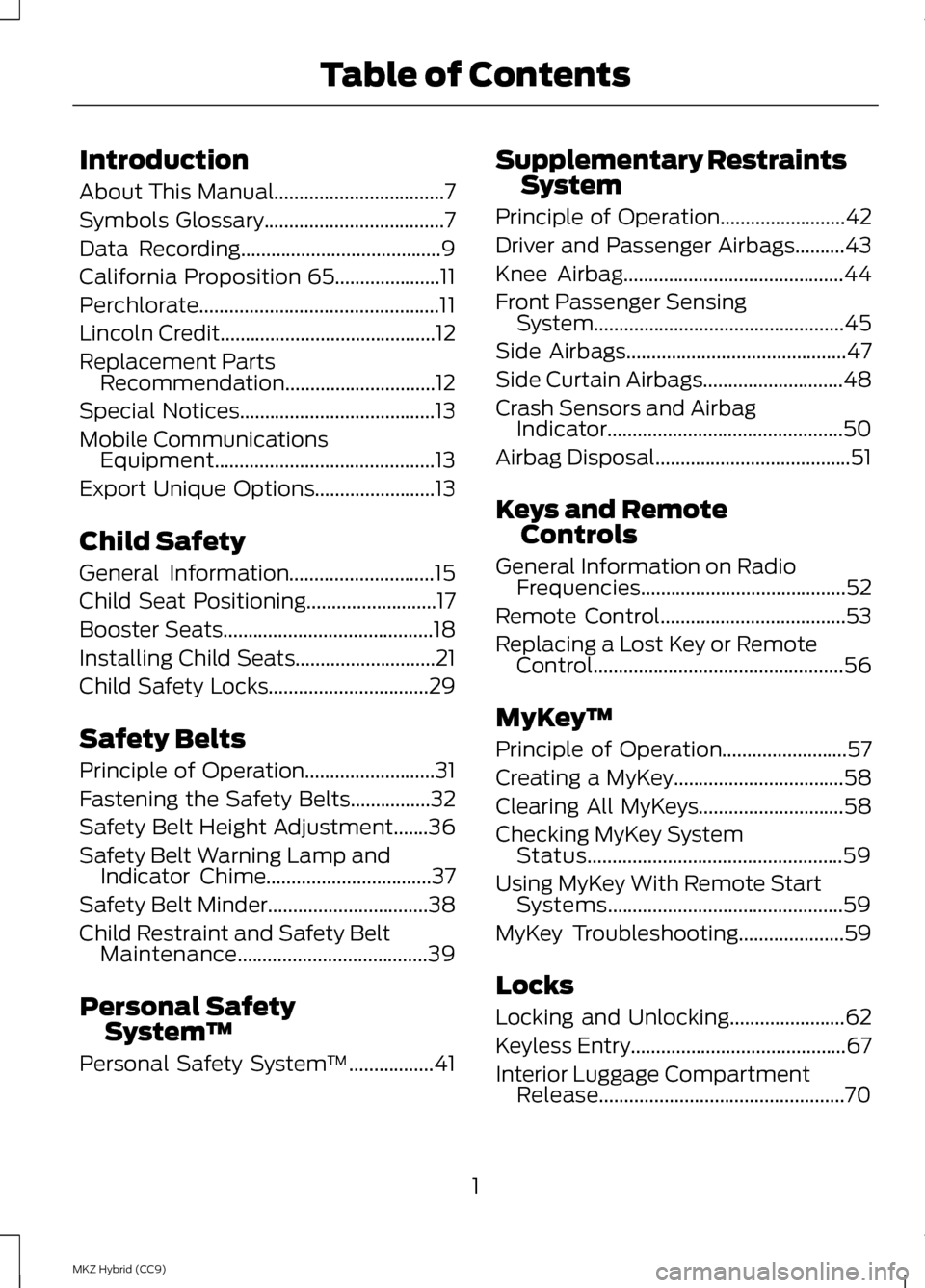
Introduction
About This Manual..................................7
Symbols Glossary
....................................7
Data Recording........................................9
California Proposition 65
.....................11
Perchlorate................................................11
Lincoln Credit
...........................................12
Replacement Parts Recommendation..............................12
Special Notices
.......................................13
Mobile Communications Equipment............................................13
Export Unique Options........................13
Child Safety
General Information.............................15
Child Seat Positioning
..........................17
Booster Seats
..........................................18
Installing Child Seats
............................21
Child Safety Locks................................29
Safety Belts
Principle of Operation..........................31
Fastening the Safety Belts................32
Safety Belt Height Adjustment.......36
Safety Belt Warning Lamp and Indicator Chime.................................37
Safety Belt Minder
................................38
Child Restraint and Safety Belt Maintenance......................................39
Personal Safety System ™
Personal Safety System ™
.................41Supplementary Restraints
System
Principle of Operation
.........................42
Driver and Passenger Airbags..........43
Knee Airbag
............................................44
Front Passenger Sensing System..................................................45
Side Airbags............................................47
Side Curtain Airbags............................48
Crash Sensors and Airbag Indicator...............................................50
Airbag Disposal.......................................51
Keys and Remote Controls
General Information on Radio Frequencies.........................................52
Remote Control
.....................................53
Replacing a Lost Key or Remote Control..................................................56
MyKey ™
Principle of Operation.........................57
Creating a MyKey
..................................58
Clearing All MyKeys.............................58
Checking MyKey System Status...................................................59
Using MyKey With Remote Start Systems...............................................59
MyKey Troubleshooting
.....................59
Locks
Locking and Unlocking.......................62
Keyless Entry...........................................67
Interior Luggage Compartment Release
.................................................70
1
MKZ Hybrid (CC9) Table of Contents
Page 17 of 475
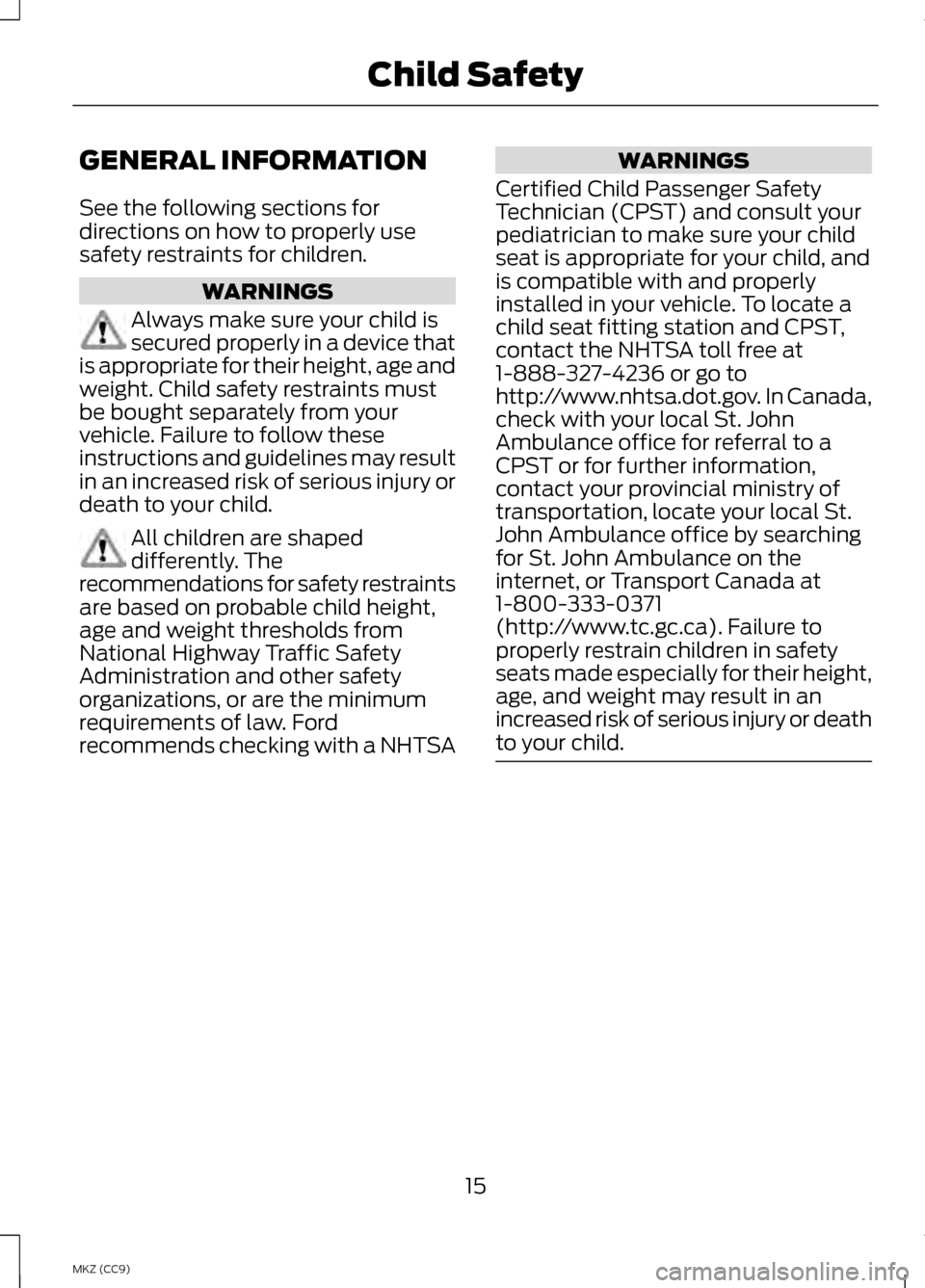
GENERAL INFORMATION
See the following sections for
directions on how to properly use
safety restraints for children.
WARNINGS
Always make sure your child is
secured properly in a device that
is appropriate for their height, age and
weight. Child safety restraints must
be bought separately from your
vehicle. Failure to follow these
instructions and guidelines may result
in an increased risk of serious injury or
death to your child. All children are shaped
differently. The
recommendations for safety restraints
are based on probable child height,
age and weight thresholds from
National Highway Traffic Safety
Administration and other safety
organizations, or are the minimum
requirements of law. Ford
recommends checking with a NHTSA WARNINGS
Certified Child Passenger Safety
Technician (CPST) and consult your
pediatrician to make sure your child
seat is appropriate for your child, and
is compatible with and properly
installed in your vehicle. To locate a
child seat fitting station and CPST,
contact the NHTSA toll free at
1-888-327-4236 or go to
http://www.nhtsa.dot.gov. In Canada,
check with your local St. John
Ambulance office for referral to a
CPST or for further information,
contact your provincial ministry of
transportation, locate your local St.
John Ambulance office by searching
for St. John Ambulance on the
internet, or Transport Canada at
1-800-333-0371
(http://www.tc.gc.ca). Failure to
properly restrain children in safety
seats made especially for their height,
age, and weight may result in an
increased risk of serious injury or death
to your child. 15
MKZ (CC9) Child Safety
Page 18 of 475
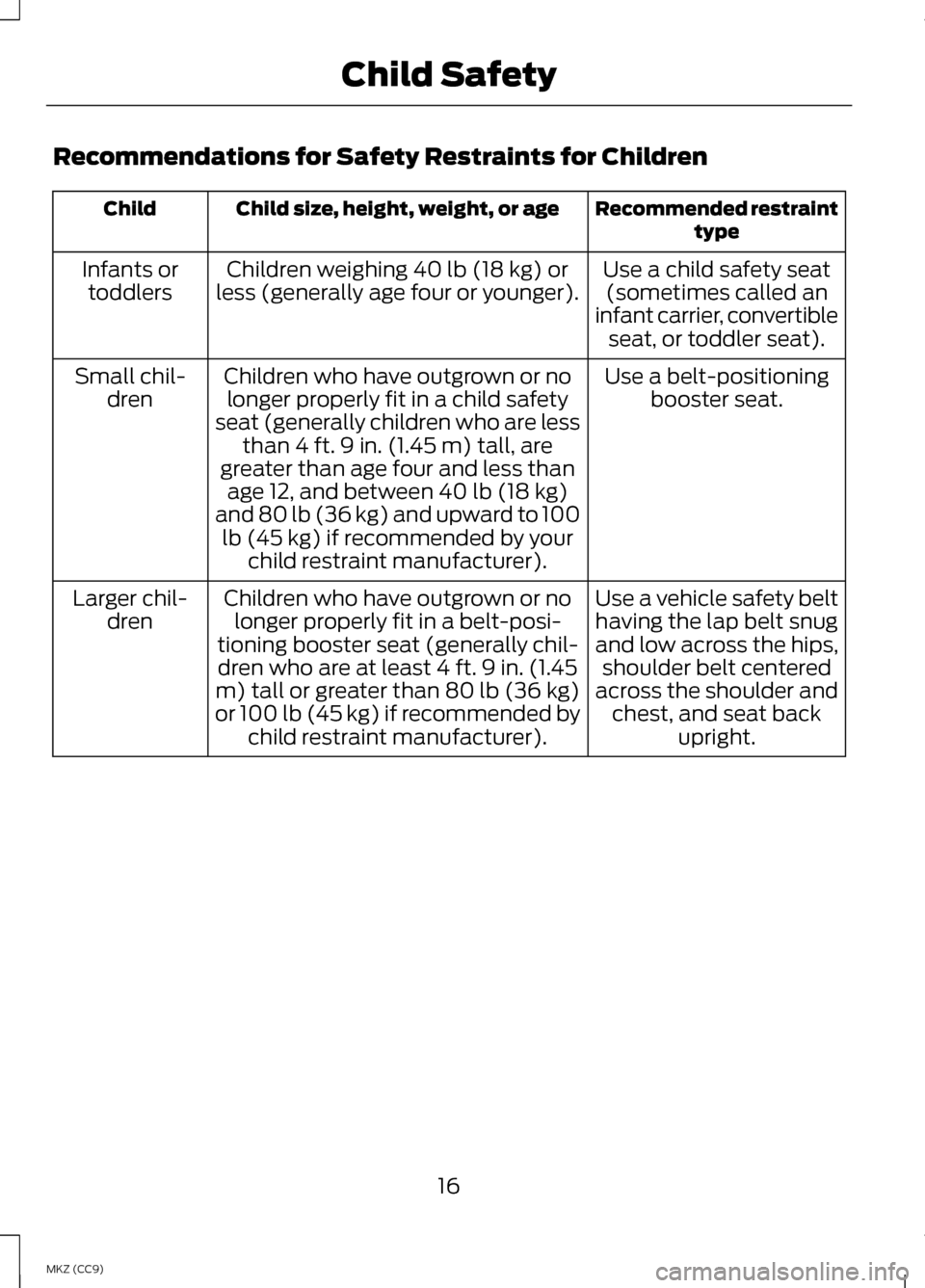
Recommendations for Safety Restraints for Children
Recommended restraint
type
Child size, height, weight, or age
Child
Use a child safety seat(sometimes called an
infant carrier, convertible seat, or toddler seat).
Children weighing 40 lb (18 kg) or
less (generally age four or younger).
Infants or
toddlers
Use a belt-positioningbooster seat.
Children who have outgrown or no
longer properly fit in a child safety
seat (generally children who are less than 4 ft. 9 in. (1.45 m) tall, are
greater than age four and less than age 12, and between 40 lb (18 kg)
and 80 lb (36 kg) and upward to 100 lb (45 kg) if recommended by your child restraint manufacturer).
Small chil-
dren
Use a vehicle safety belthaving the lap belt snug
and low across the hips, shoulder belt centered
across the shoulder and chest, and seat back upright.
Children who have outgrown or no
longer properly fit in a belt-posi-
tioning booster seat (generally chil- dren who are at least 4 ft. 9 in. (1.45
m) tall or greater than 80 lb (36 kg)
or 100 lb (45 kg) if recommended by child restraint manufacturer).
Larger chil-
dren
16
MKZ (CC9) Child Safety
Page 19 of 475
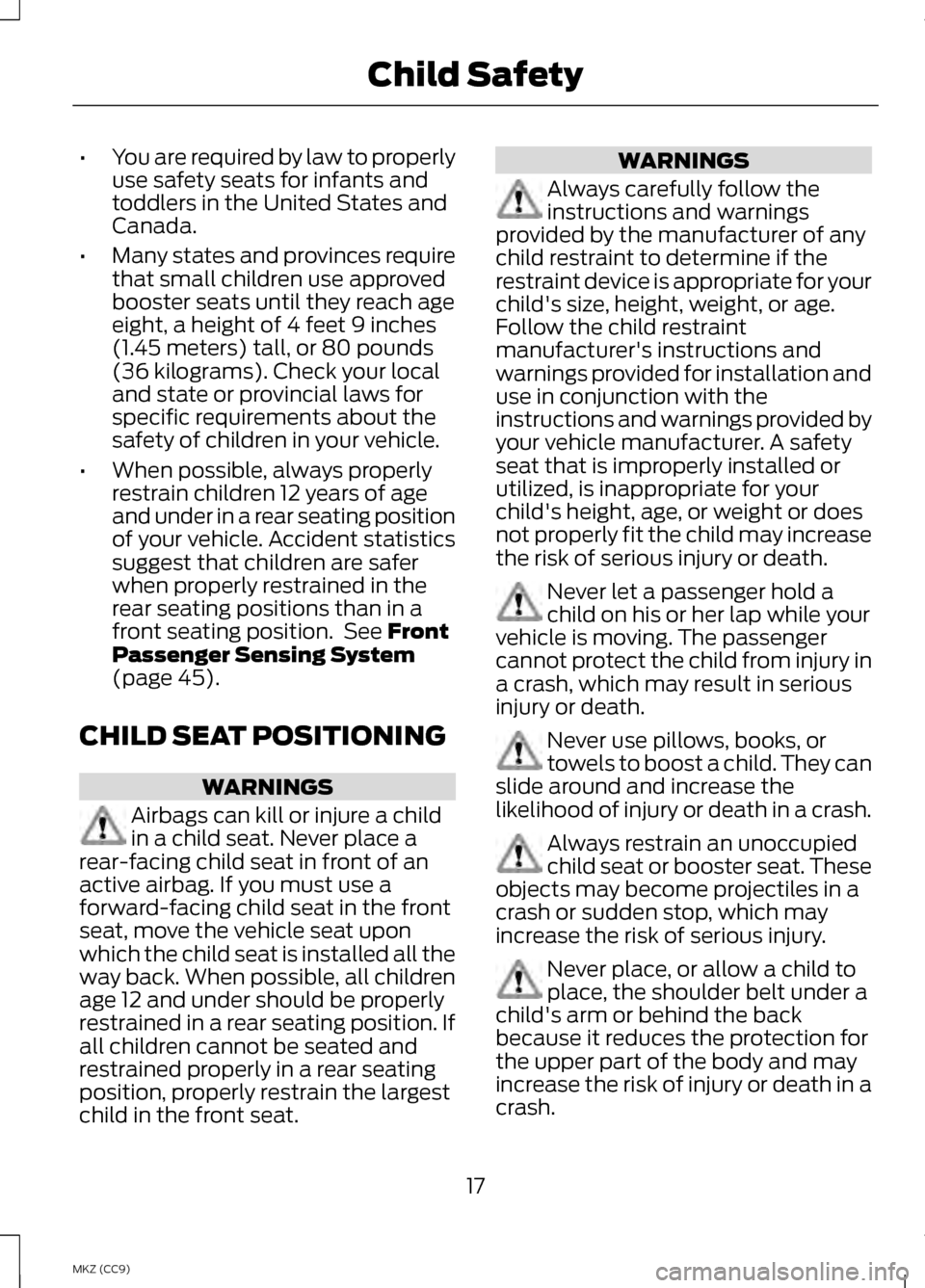
•
You are required by law to properly
use safety seats for infants and
toddlers in the United States and
Canada.
• Many states and provinces require
that small children use approved
booster seats until they reach age
eight, a height of 4 feet 9 inches
(1.45 meters) tall, or 80 pounds
(36 kilograms). Check your local
and state or provincial laws for
specific requirements about the
safety of children in your vehicle.
• When possible, always properly
restrain children 12 years of age
and under in a rear seating position
of your vehicle. Accident statistics
suggest that children are safer
when properly restrained in the
rear seating positions than in a
front seating position. See Front
Passenger Sensing System
(page
45).
CHILD SEAT POSITIONING WARNINGS
Airbags can kill or injure a child
in a child seat. Never place a
rear-facing child seat in front of an
active airbag. If you must use a
forward-facing child seat in the front
seat, move the vehicle seat upon
which the child seat is installed all the
way back. When possible, all children
age 12 and under should be properly
restrained in a rear seating position. If
all children cannot be seated and
restrained properly in a rear seating
position, properly restrain the largest
child in the front seat. WARNINGS
Always carefully follow the
instructions and warnings
provided by the manufacturer of any
child restraint to determine if the
restraint device is appropriate for your
child's size, height, weight, or age.
Follow the child restraint
manufacturer's instructions and
warnings provided for installation and
use in conjunction with the
instructions and warnings provided by
your vehicle manufacturer. A safety
seat that is improperly installed or
utilized, is inappropriate for your
child's height, age, or weight or does
not properly fit the child may increase
the risk of serious injury or death. Never let a passenger hold a
child on his or her lap while your
vehicle is moving. The passenger
cannot protect the child from injury in
a crash, which may result in serious
injury or death. Never use pillows, books, or
towels to boost a child. They can
slide around and increase the
likelihood of injury or death in a crash. Always restrain an unoccupied
child seat or booster seat. These
objects may become projectiles in a
crash or sudden stop, which may
increase the risk of serious injury. Never place, or allow a child to
place, the shoulder belt under a
child's arm or behind the back
because it reduces the protection for
the upper part of the body and may
increase the risk of injury or death in a
crash.
17
MKZ (CC9) Child Safety
Page 21 of 475
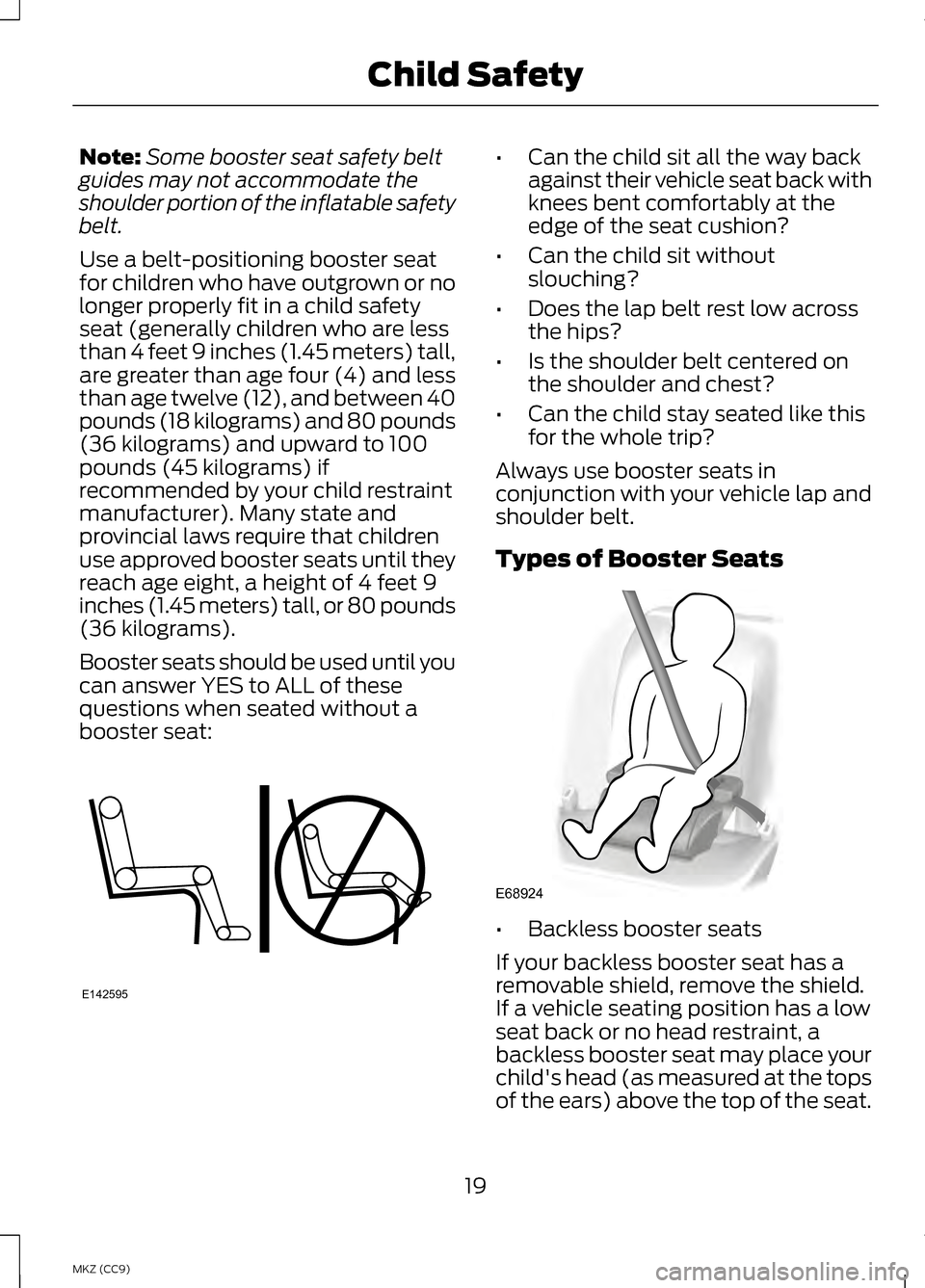
Note:
Some booster seat safety belt
guides may not accommodate the
shoulder portion of the inflatable safety
belt.
Use a belt-positioning booster seat
for children who have outgrown or no
longer properly fit in a child safety
seat (generally children who are less
than 4 feet 9 inches (1.45 meters) tall,
are greater than age four (4) and less
than age twelve (12), and between 40
pounds (18 kilograms) and 80 pounds
(36 kilograms) and upward to 100
pounds (45 kilograms) if
recommended by your child restraint
manufacturer). Many state and
provincial laws require that children
use approved booster seats until they
reach age eight, a height of 4 feet 9
inches (1.45 meters) tall, or 80 pounds
(36 kilograms).
Booster seats should be used until you
can answer YES to ALL of these
questions when seated without a
booster seat: •
Can the child sit all the way back
against their vehicle seat back with
knees bent comfortably at the
edge of the seat cushion?
• Can the child sit without
slouching?
• Does the lap belt rest low across
the hips?
• Is the shoulder belt centered on
the shoulder and chest?
• Can the child stay seated like this
for the whole trip?
Always use booster seats in
conjunction with your vehicle lap and
shoulder belt.
Types of Booster Seats •
Backless booster seats
If your backless booster seat has a
removable shield, remove the shield.
If a vehicle seating position has a low
seat back or no head restraint, a
backless booster seat may place your
child's head (as measured at the tops
of the ears) above the top of the seat.
19
MKZ (CC9) Child SafetyE142595 E68924
Page 34 of 475
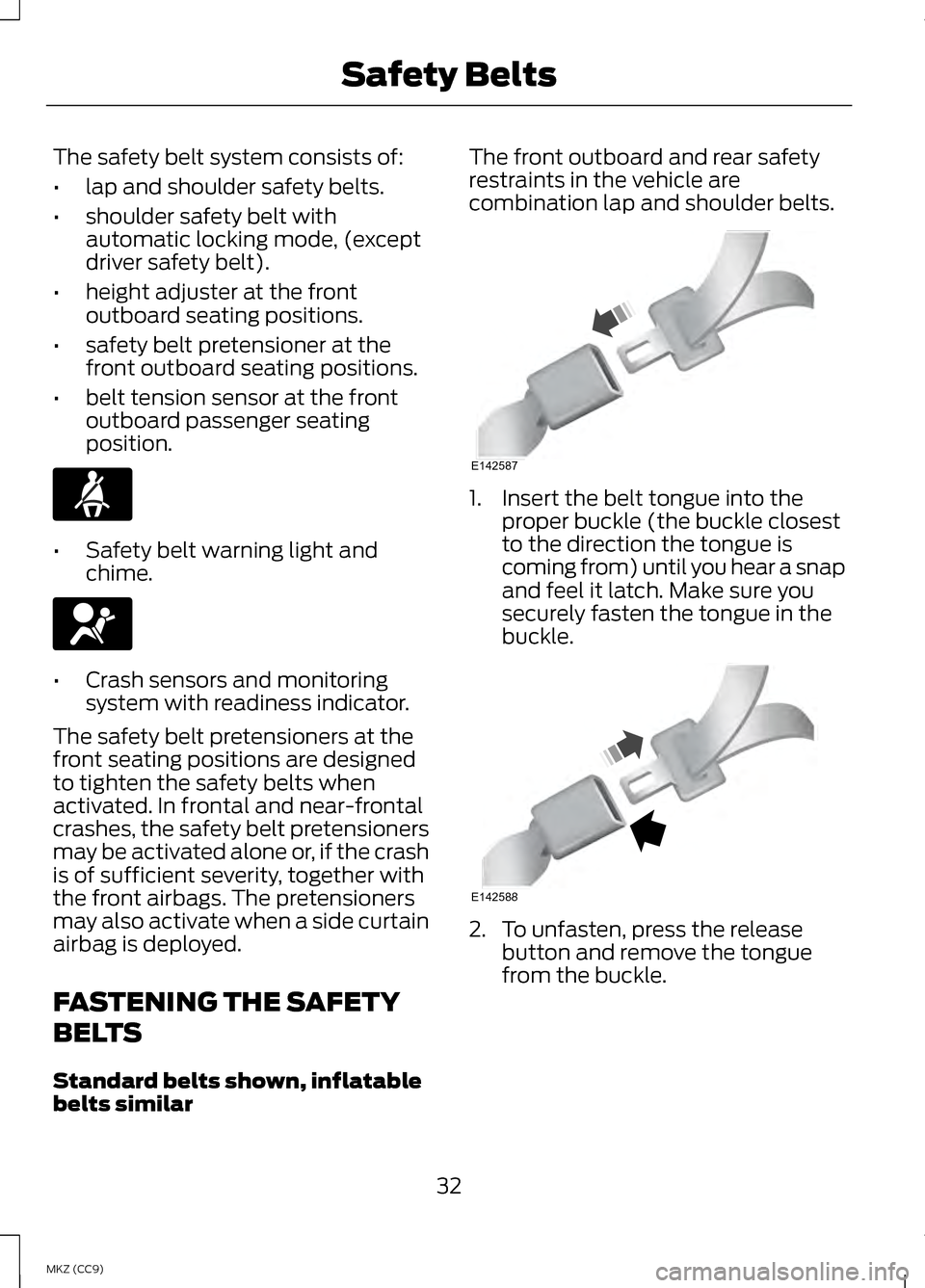
The safety belt system consists of:
•
lap and shoulder safety belts.
• shoulder safety belt with
automatic locking mode, (except
driver safety belt).
• height adjuster at the front
outboard seating positions.
• safety belt pretensioner at the
front outboard seating positions.
• belt tension sensor at the front
outboard passenger seating
position. •
Safety belt warning light and
chime. •
Crash sensors and monitoring
system with readiness indicator.
The safety belt pretensioners at the
front seating positions are designed
to tighten the safety belts when
activated. In frontal and near-frontal
crashes, the safety belt pretensioners
may be activated alone or, if the crash
is of sufficient severity, together with
the front airbags. The pretensioners
may also activate when a side curtain
airbag is deployed.
FASTENING THE SAFETY
BELTS
Standard belts shown, inflatable
belts similar The front outboard and rear safety
restraints in the vehicle are
combination lap and shoulder belts.
1. Insert the belt tongue into the
proper buckle (the buckle closest
to the direction the tongue is
coming from) until you hear a snap
and feel it latch. Make sure you
securely fasten the tongue in the
buckle. 2. To unfasten, press the release
button and remove the tongue
from the buckle.
32
MKZ (CC9) Safety Belts E142587 E142588
Page 38 of 475
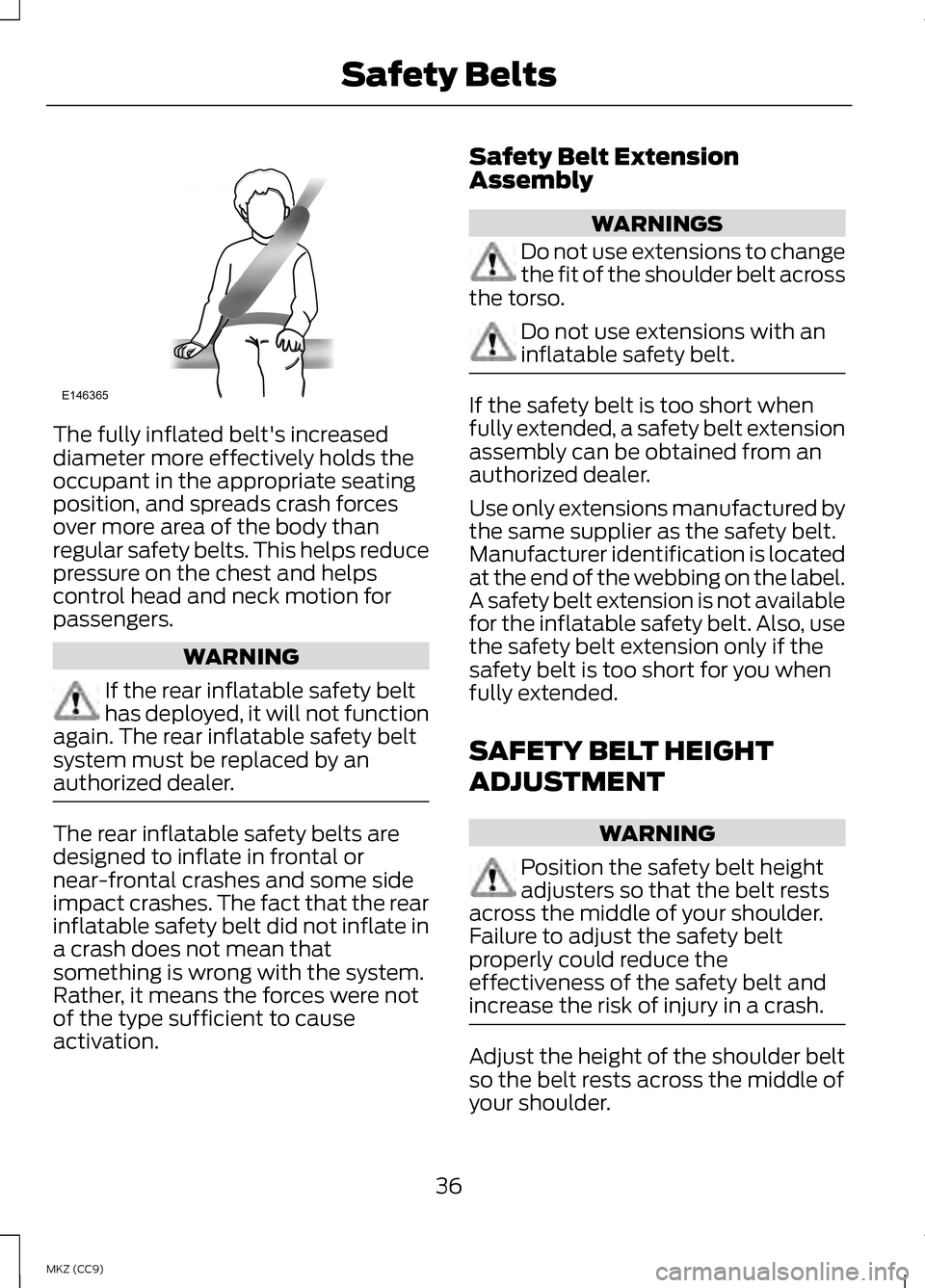
The fully inflated belt's increased
diameter more effectively holds the
occupant in the appropriate seating
position, and spreads crash forces
over more area of the body than
regular safety belts. This helps reduce
pressure on the chest and helps
control head and neck motion for
passengers.
WARNING
If the rear inflatable safety belt
has deployed, it will not function
again. The rear inflatable safety belt
system must be replaced by an
authorized dealer. The rear inflatable safety belts are
designed to inflate in frontal or
near-frontal crashes and some side
impact crashes. The fact that the rear
inflatable safety belt did not inflate in
a crash does not mean that
something is wrong with the system.
Rather, it means the forces were not
of the type sufficient to cause
activation. Safety Belt Extension
Assembly WARNINGS
Do not use extensions to change
the fit of the shoulder belt across
the torso. Do not use extensions with an
inflatable safety belt.
If the safety belt is too short when
fully extended, a safety belt extension
assembly can be obtained from an
authorized dealer.
Use only extensions manufactured by
the same supplier as the safety belt.
Manufacturer identification is located
at the end of the webbing on the label.
A safety belt extension is not available
for the inflatable safety belt. Also, use
the safety belt extension only if the
safety belt is too short for you when
fully extended.
SAFETY BELT HEIGHT
ADJUSTMENT
WARNING
Position the safety belt height
adjusters so that the belt rests
across the middle of your shoulder.
Failure to adjust the safety belt
properly could reduce the
effectiveness of the safety belt and
increase the risk of injury in a crash. Adjust the height of the shoulder belt
so the belt rests across the middle of
your shoulder.
36
MKZ (CC9) Safety BeltsE146365
Page 39 of 475
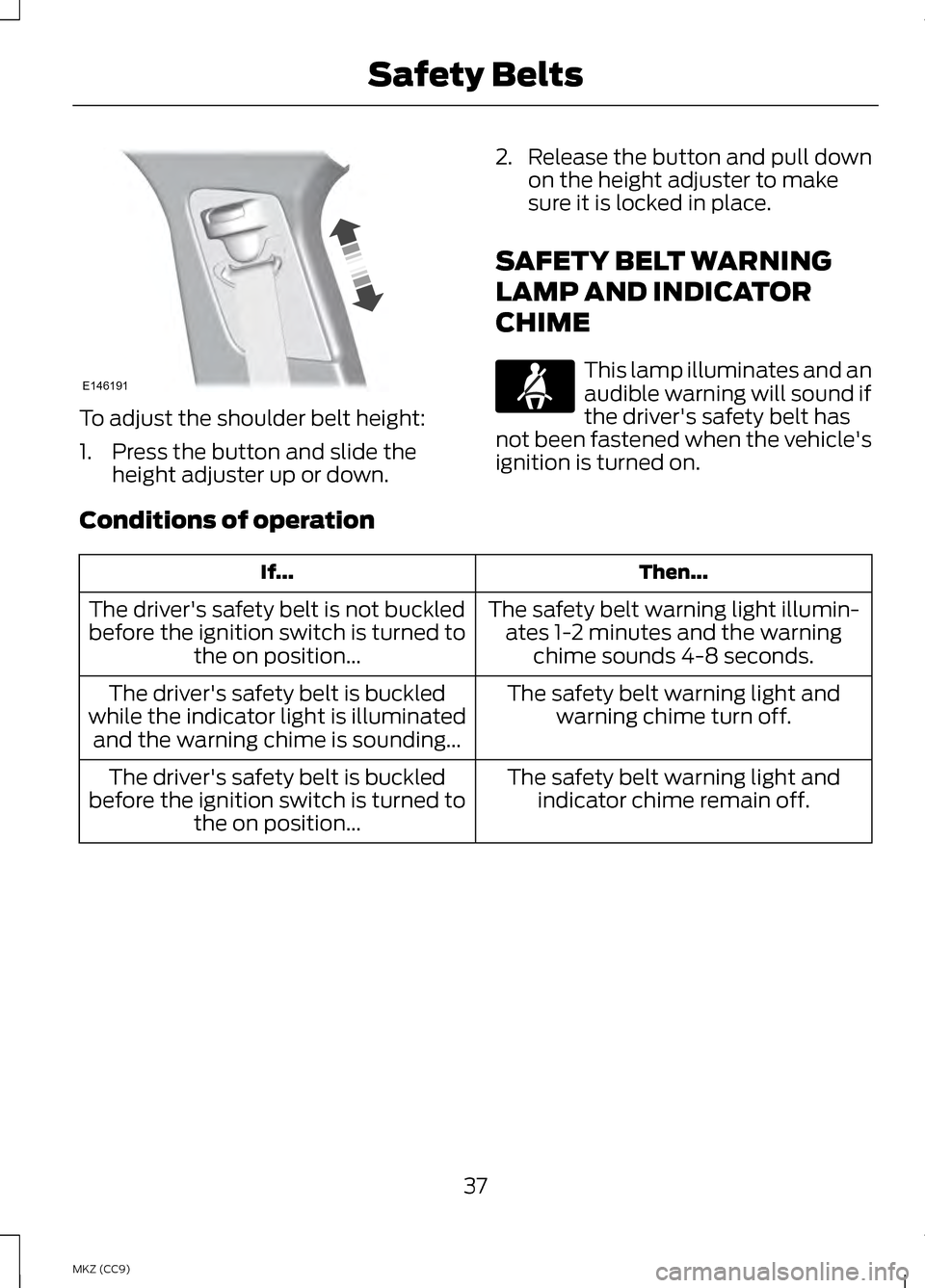
To adjust the shoulder belt height:
1. Press the button and slide the
height adjuster up or down. 2. Release the button and pull down
on the height adjuster to make
sure it is locked in place.
SAFETY BELT WARNING
LAMP AND INDICATOR
CHIME This lamp illuminates and an
audible warning will sound if
the driver's safety belt has
not been fastened when the vehicle's
ignition is turned on.
Conditions of operation Then...
If...
The safety belt warning light illumin-ates 1-2 minutes and the warning chime sounds 4-8 seconds.
The driver's safety belt is not buckled
before the ignition switch is turned to the on position...
The safety belt warning light andwarning chime turn off.
The driver's safety belt is buckled
while the indicator light is illuminated and the warning chime is sounding...
The safety belt warning light andindicator chime remain off.
The driver's safety belt is buckled
before the ignition switch is turned to the on position...
37
MKZ (CC9) Safety BeltsE146191
Page 42 of 475
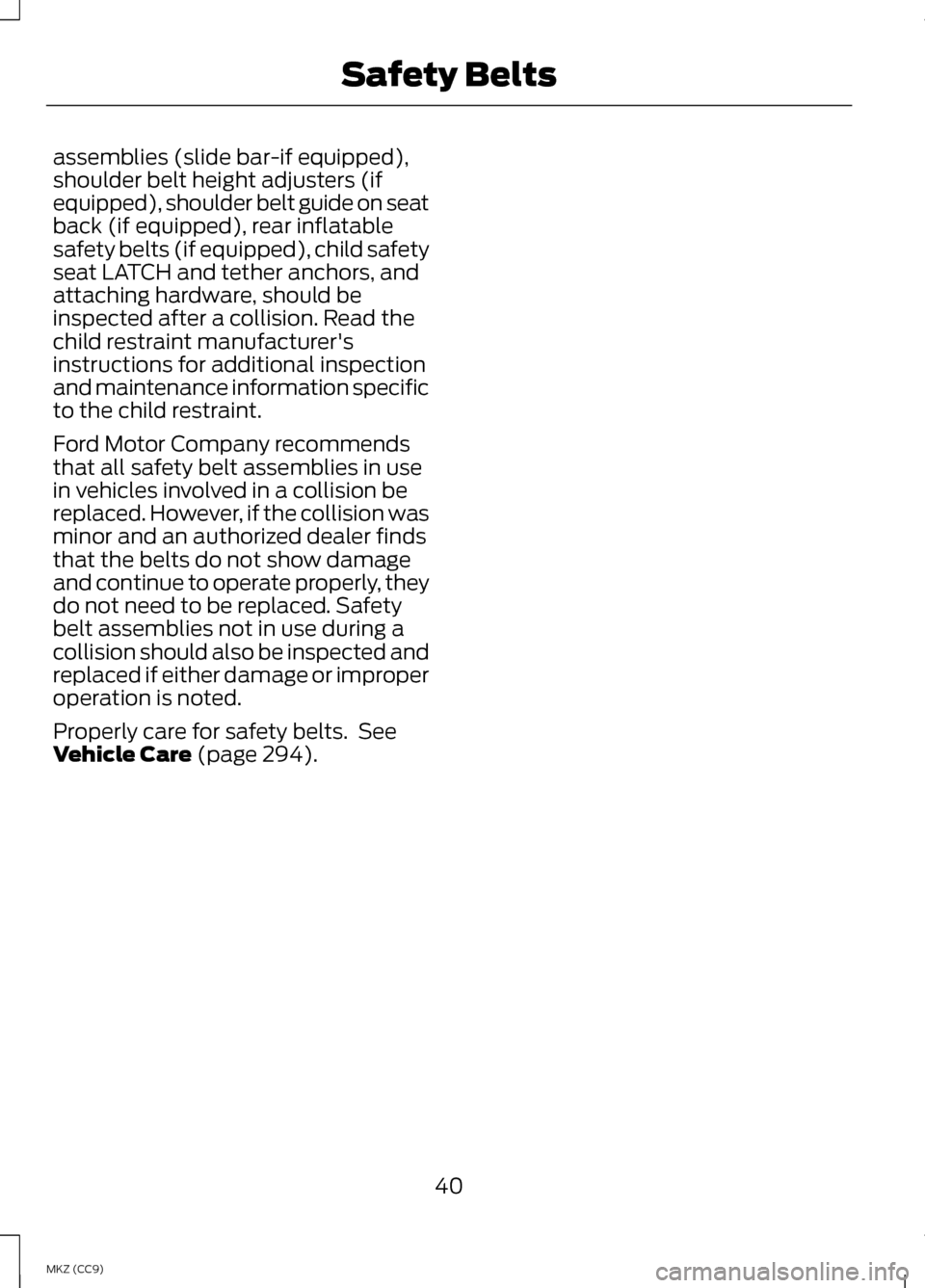
assemblies (slide bar-if equipped),
shoulder belt height adjusters (if
equipped), shoulder belt guide on seat
back (if equipped), rear inflatable
safety belts (if equipped), child safety
seat LATCH and tether anchors, and
attaching hardware, should be
inspected after a collision. Read the
child restraint manufacturer's
instructions for additional inspection
and maintenance information specific
to the child restraint.
Ford Motor Company recommends
that all safety belt assemblies in use
in vehicles involved in a collision be
replaced. However, if the collision was
minor and an authorized dealer finds
that the belts do not show damage
and continue to operate properly, they
do not need to be replaced. Safety
belt assemblies not in use during a
collision should also be inspected and
replaced if either damage or improper
operation is noted.
Properly care for safety belts. See
Vehicle Care (page 294).
40
MKZ (CC9) Safety Belts
Page 86 of 475
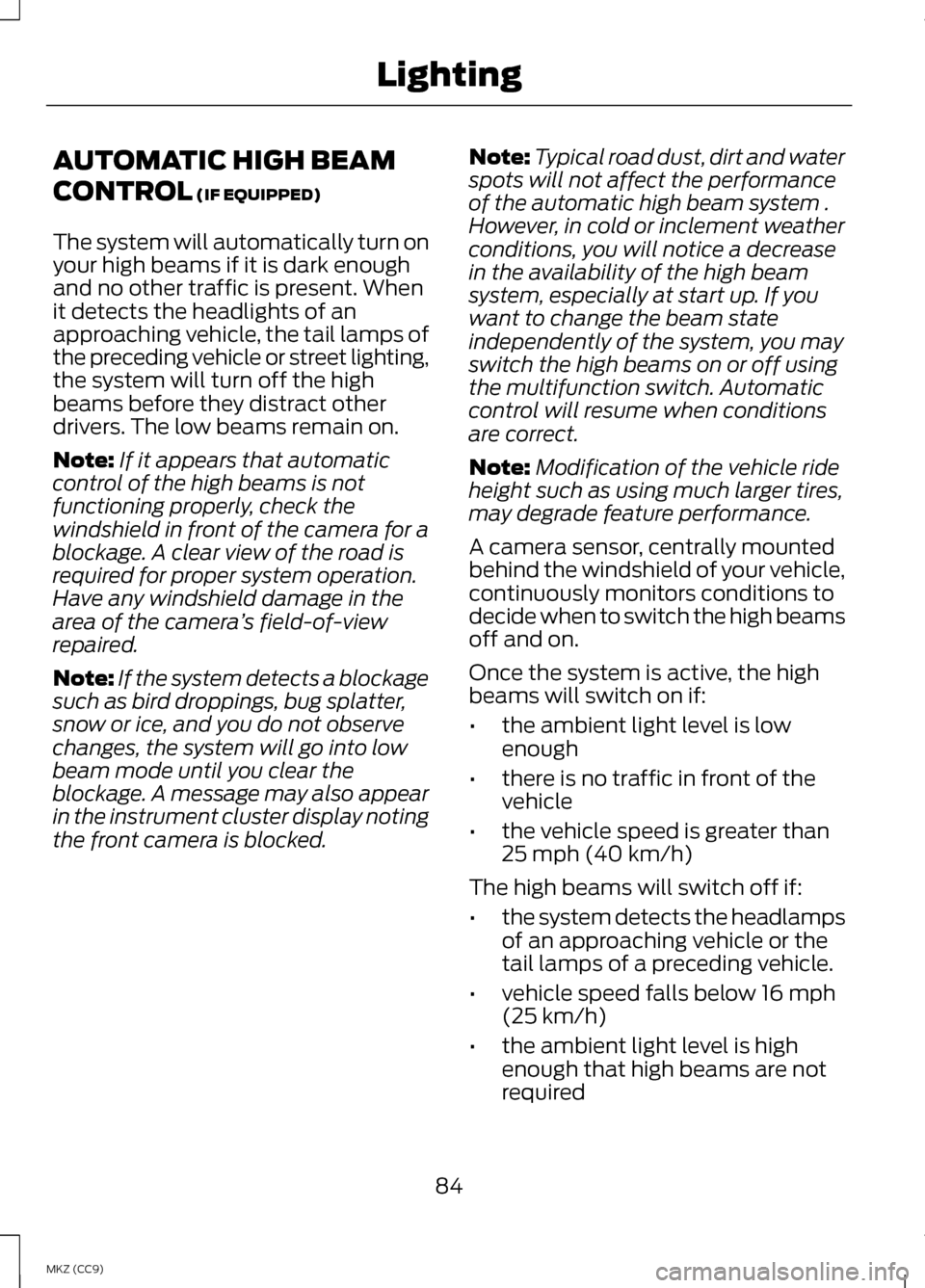
AUTOMATIC HIGH BEAM
CONTROL (IF EQUIPPED)
The system will automatically turn on
your high beams if it is dark enough
and no other traffic is present. When
it detects the headlights of an
approaching vehicle, the tail lamps of
the preceding vehicle or street lighting,
the system will turn off the high
beams before they distract other
drivers. The low beams remain on.
Note: If it appears that automatic
control of the high beams is not
functioning properly, check the
windshield in front of the camera for a
blockage. A clear view of the road is
required for proper system operation.
Have any windshield damage in the
area of the camera ’s field-of-view
repaired.
Note: If the system detects a blockage
such as bird droppings, bug splatter,
snow or ice, and you do not observe
changes, the system will go into low
beam mode until you clear the
blockage. A message may also appear
in the instrument cluster display noting
the front camera is blocked. Note:
Typical road dust, dirt and water
spots will not affect the performance
of the automatic high beam system .
However, in cold or inclement weather
conditions, you will notice a decrease
in the availability of the high beam
system, especially at start up. If you
want to change the beam state
independently of the system, you may
switch the high beams on or off using
the multifunction switch. Automatic
control will resume when conditions
are correct.
Note: Modification of the vehicle ride
height such as using much larger tires,
may degrade feature performance.
A camera sensor, centrally mounted
behind the windshield of your vehicle,
continuously monitors conditions to
decide when to switch the high beams
off and on.
Once the system is active, the high
beams will switch on if:
• the ambient light level is low
enough
• there is no traffic in front of the
vehicle
• the vehicle speed is greater than
25 mph (40 km/h)
The high beams will switch off if:
• the system detects the headlamps
of an approaching vehicle or the
tail lamps of a preceding vehicle.
• vehicle speed falls below
16 mph
(25 km/h)
• the ambient light level is high
enough that high beams are not
required
84
MKZ (CC9) Lighting